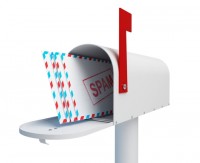What Spam Can Teach You About Copywriting
Have your clients ever fallen for the “Your website isn’t ranked in the top Google results” emails? You know. The type of email that you receive multiple times a day from multiple companies.
There’s a reason for that.
One of my clients sent one of those emails with the note, “My CEO wanted me to forward this to you. What do you think?”
At first, I started questioning the client’s business savvy, thinking, “They fell for this? Really?” And then I looked at the email a tad more closely.
We may not like spammy emails. But we can learn why they work (because they do work), despite the typos and poor grammar. Let’s break down what they do – and discuss how you can (ethically) use this technique in your own writing.
For instance, here are some common “spammy” statements:
We noticed that you are not at the top of the search engines for a number of your key words related to your business or within your page currently.
This plays on every marketer’s fear. In their heads, they’re wondering,”What do you mean that I’m not at the top of the engines? What did this company search for? I thought I was doing OK.”
This sentence exposes a raw nerve of fear and doubt. And the business owner is left thinking, “No matter how well I thought I was doing, maybe I’m not doing well enough…?”
I particularly enjoy the phrase “we noticed that you are not at the top of the search results.” It almost makes it sound like a team of people were reviewing the site and were compelled to send this email. Now, you and I both know that this is automated spam. But from a copywriting perspective, “we noticed,” gives the phrase slightly more street cred.
Fear is definitely a marketing hot-button that you can push. If your target market’s main concern is fear-based (for instance a security company may know that a main sales point is the fear of getting robbed,) playing on that fear can instantly grab the reader’s attention.
We have helped companies similar to yours to achieve the top position (1st Page) on many search engines such as Google, Yahoo, Bing, etc.
Whew! The company has told me that my rankings sucked – but they can help. The email has brought up a problem, and the company has countered with a “Don’t worry, we can help” solution.
This “We understand your problem/here’s the solution” is a very tried and true copywriting technique that’s applicable to B2B and B2C sites.
Additionally, this sentence showcases an OK use of the bandwagon approach. The bandwagon approach is when the copy emphasizes that other people are doing/buying X — so you should too (as a side note, this is why testimonials work so well.)
A better approach would be if they could target the emails by vertical. Then, the company could change up the text and say things like, “We’ve helped other heavy equipment manufacturers like you.” See how making the sentence a tad more specific provides a bigger impact?
Next week, I’ll share two other content “tricks” that you’ll learn from spam emails. Plus, if you have a favorite spam email to share, send it over. I can break it down and discuss how and why it really works (who knew?).


These emails are the worst. They can get owners of the best performing websites nervous. I’ve had to explain to more than a few clients over the years that the emails are nothing but spam. You can’t guarantee to get a website to the first page of a SERP.